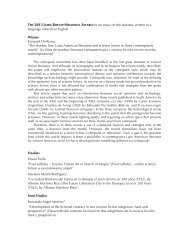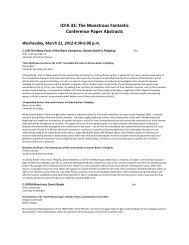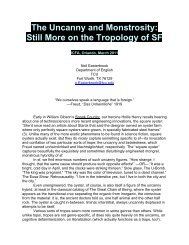The Monstrous Fantastic Conference Paper Abstracts - International ...
The Monstrous Fantastic Conference Paper Abstracts - International ...
The Monstrous Fantastic Conference Paper Abstracts - International ...
Create successful ePaper yourself
Turn your PDF publications into a flip-book with our unique Google optimized e-Paper software.
<strong>Monstrous</strong> Controls: <strong>The</strong> Illusion of Control in Survival Horror Video GamesEdward HowarthLongwood UniversityClive Barker notes that “[Horror] shows us that the control we believe we have is purely illusory, and that every moment we teeter on chaosand oblivion.” In horror literature and film, it is this instability of control that lends itself to the fear we feel when, as mere observers, we lookon helplessly at the characters fumbling through the dark. However, though this lack of control is true of literature and film, video games -where the observer becomes participant, the reader becomes player- prove the exception. Physically guiding characters through murkyswamps, mouldering corridors, demonic classrooms, the control given to us in survival horror games is far from illusionary. Instead, we aregranted direct control over the characters, control that allows us to succesfully combat the various fiends and horrors dealt to us throughoutthe game’s narrative. However, if fear is generated through a loss of control, a question is raised regarding how a horror video game can createfear if the player is constantly in control. This proposed essay will explore how survival horror video games use controls to make us feel out ofcontrol, pursuing the idea that, though we may seem to have control, we are never truly in control.96. (H/FTV) Dirty Little Secrets DogwoodChair: Beth FeaganLongwood UniversitySexing the Vampire in Gothic Literature: How Repressed Sexuality Shaped a Modern MonsterAngela StillUniversity of Southern MaineIn the wake of the Industrial Revolution, British society was restructured along unbendable gender lines. Overt repression of women andhomosexuals not only intensified, but became the social norm, and was, in some cases, enforceable by law. Gender roles were strictlyredefined, resulting in an idealized definition of family and family life. This definition was so confining, anyone who did not adhere to it becamea social outcast. This environment spawned Gothic literature, a popular form of fiction that allowed the “other” to express its fears andfrustrations in a safe but public forum through the use of highly stylized settings, family plots, and monstrous beings. Gothic fiction’s extremepopularity faded somewhat in the mid-twentieth century, though it never completely died out. In the late 1960s and early 1970s, however, thegenre enjoyed a revival in America, where many of the same issues that originally gave birth to Gothic had resurfaced. In 1976, Anne Ricepublished Interview with the Vampire, and the Gothic novel once again reflected society’s anxiety about gender roles and their definitions. <strong>The</strong>success of Rice’s debut injected both the Gothic genre and the vampire myth with new life, providing the catalyst that would pave the way forthe vampire to become the sociosexual phenomenon it is today – a preternatural creature who embraces a future without the limitations ofgender – and for Gothic literature to regain its place at the forefront of popular fiction.Female Abominations: Undermining Male Hegemony in H. Rider Haggard’s SheGareth Hadyk-DeLodderUniversity of FloridaNineteenth-century monstrosity comes, fittingly enough, in many shapes and sizes. It is not surprising, then, that a historical period whichwitnessed a meteoric rise in evolutionary thought, degeneration theory, and psychological inquiry would have given birth to or popularizedsome of the archetypal monsters that we recognize and embrace today: the vampire, the doubled man (Jekyll and Hyde), Frankenstein’soriginal monster, and many more. <strong>The</strong>re is a wealth of critical readings concerning each, which help us to map out many of the ways in whichwe can view the “monster” as an essential part of a nineteenth-century or a Victorian zeitgeist. Fewer readings are available, however, of somelesser known but equally “horrifying” characters, including, as I will argue here, a radically “Other” priestess figure who was prominent in someof the fictions of H. Rider Haggard and Marie Corelli. Over the course of this presentation, I will explore how the trope of the foreign priestess,whether located in a fantastical, alternative geography (Haggard) or a fictional history (Corelli), destabilized and, in some cases, violentlysubverted many established Victorian epistemologies. Specifically, I would like to outline some of the ways that Haggard’s She (1886-1887) andCorelli’s Ardath (1889) position their respective priestess figures—the iconic Ayesha in Haggard’s text and Lysia in Corelli’s—as a counterpointto orthodox narratives of female ontology and agency. Published within two years of each other, both novels were extraordinarily popular,outselling many of their more respected (and now considered canonical) contemporaries. <strong>The</strong> two novels, then, are uniquely situated to helpframe some of my questions concerning the nature of male horror after their encounters with the two women, and how Ayesha and Lysiaembody Victorian anxieties about science, religion, and gender.Weaponizing Seduction: Exploring Sexual Violence in Ghost FictionManuel TejedaBarry UniversityNoelle BowlesKent State – TrumbullGhosts are at once the most ubiquitous undead as well as the most distant and secretive of their kin. <strong>The</strong>y are culturally universal and as onceliving humans, are psychologically familiar to us. We can sympathize with their motives and circumstances at their death to rationalize theircurrent activities and existence despite their poor methods of communication, through psychic mediums or weird electronic devices of dubiouseffect. Yet that familiarity extends only to the psychological as the physical experience is only available to ghosts as memory and to us only asimagination. As once living beings, we presume all undead types share the former sexuality of the living from which they were created. Yetthat sexuality, particular the seductive elements of the sexual experience are overlooked in the fiction of ghosts. <strong>The</strong> corporeal undead havevery clear reasons for corporeal seductive engagement with the living: vampires/blood. While other undead employ seduction for some form





